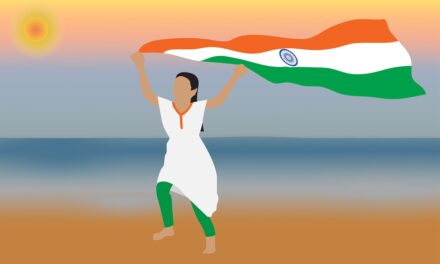The Mapusa Mogi mural project is an ongoing community-centric public art project located in the city of Mapusa in North Goa, India. Its scale and scope is ambitious as it seeks to represent the past, present and potential future of this historic market town. The aim is to create a large and yet very detailed ceramic mural on a 100-metre-long and 8-meter-high wall located in the heart of the city.
Watch the unveiling and launch of the first part of the Mapusa Mogi mural in Mapusa here.
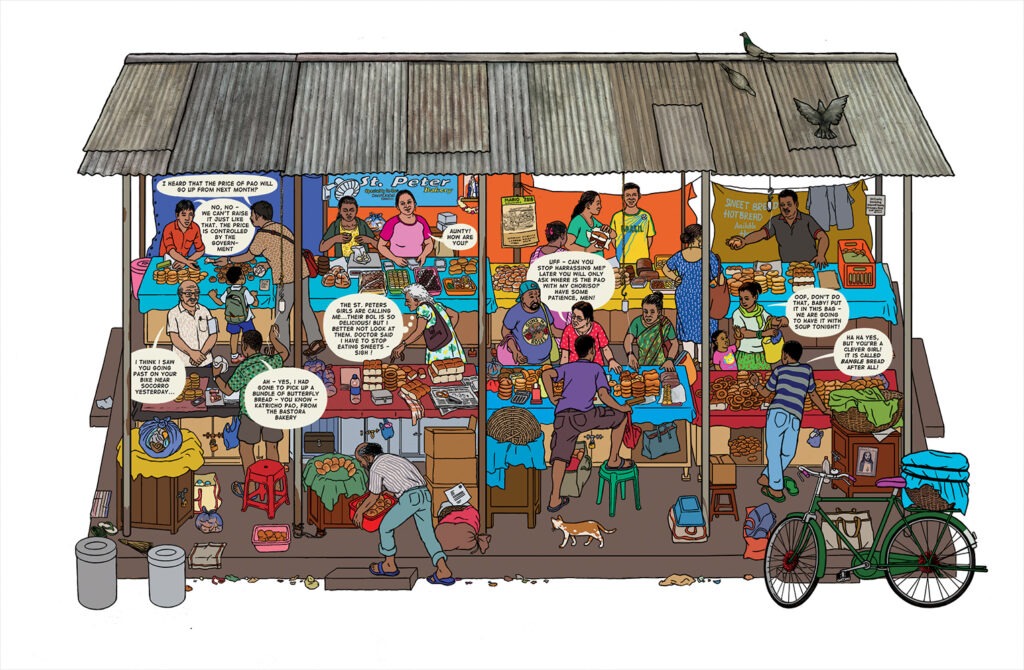
BREAD SHED. While rice is the traditional staple food of Goa, bread and bread-making were introduced by Portuguese colonialists in the 16th century. Over time, Goa developed a distinctive and rich tradition of baking culture and cuisine. Amost every large village in Goa has its own local bakery making various types of breads, cakes and pastries. Mapusa market has an entire section devoted to breads, supplied from various villages around North Goa. The bread types have interesting local names. For example, a hard-crust doughnut-shaped bread is called ‘Kangon’ – the Konkani-language word for ‘bangle’. Typically, the freshly baked breads go out to individual homes via ‘Poders’ — delivery men who ride bicycles fitted with big bread baskets, and distinctive sounding air-horns used to announce their arrival in a neighborhood.
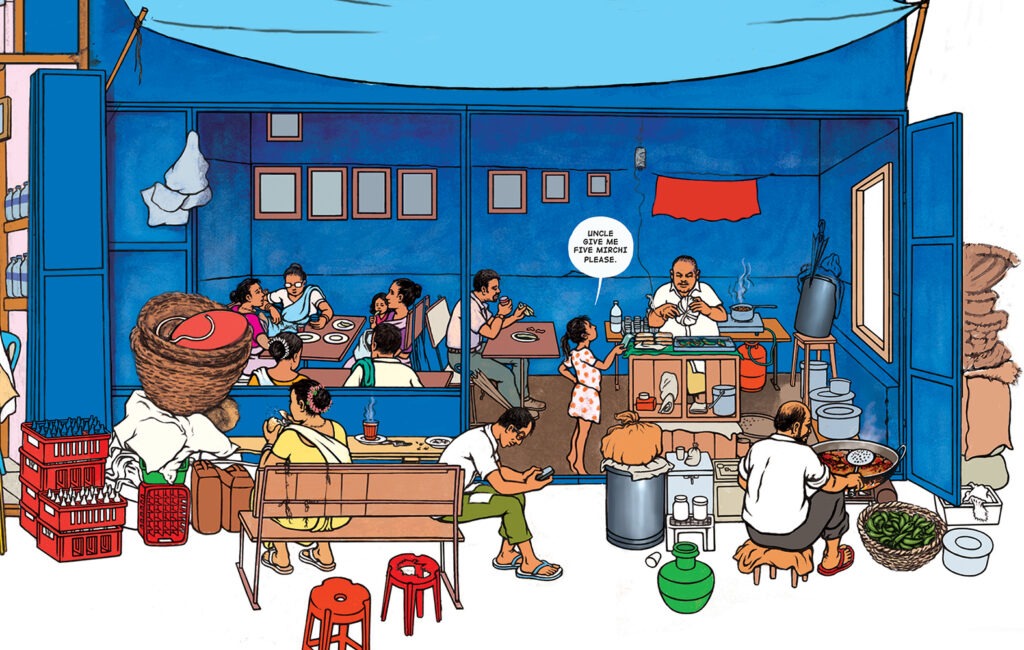
CHAI AND MIRCHI. Mirchi, or Mirchi Bhaji, is a much loved street food of Goa. Mirchis are made by dipping large jalapeno-type chillies in a thick powdered-chickpea batter and deep frying in very hot cooking oil. They are savoury, piquant and make for a delicious snack — usually combined with sweet, milky, piping-hot Chai. The Tea stall depicted here is one of the most popular in Mapusa market. Most of the market vendors gather here after a hard day of doing business, to catch up on news, gossip and relaxation.
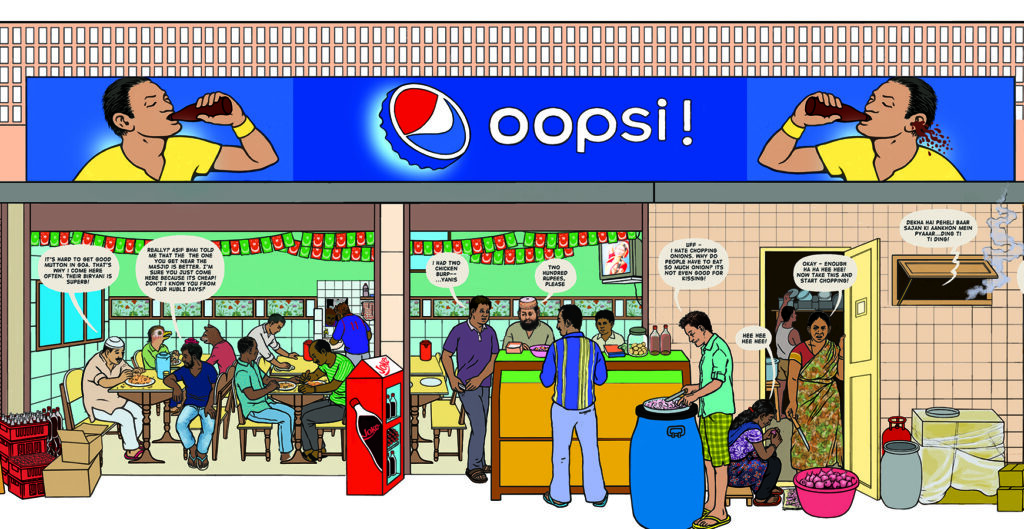
BIRYANI JOINT. Biryani – a dish made of meats (lamb or chicken), rice and fragrant spices, is beloved in many parts of India, and there are different versions of Biryani in each of these regions. It is associated with Islamic culture and cuisine, and in Mapusa there are a couple of restaurants specializing in Biryani. This one is located within the market area.
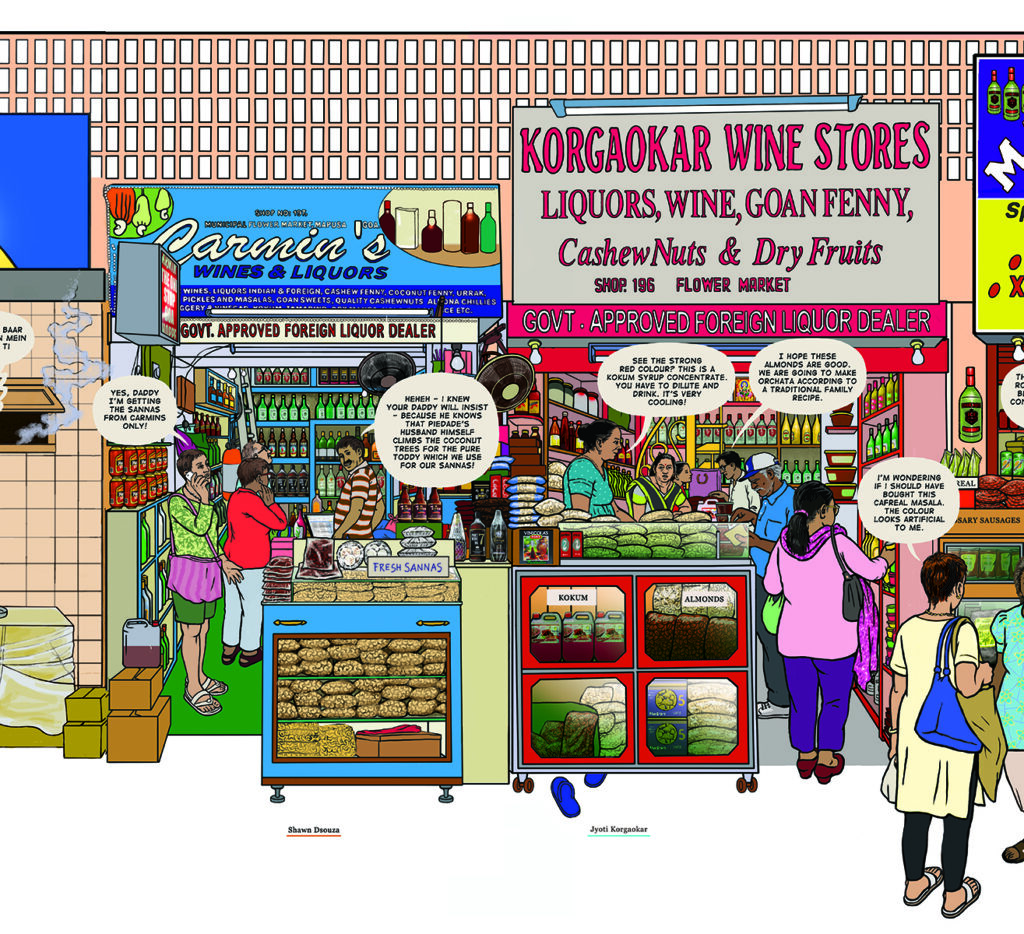
CARMINS. Carmins Stores stock cashew nuts and cashew products, liquor and wines, and local cottage industry food products such as Sannas — fermented rice cakes sweetened with coconut jaggery. The fermenting agent used is fresh coconut toddy, which gives Sannas a distinctive flavour.
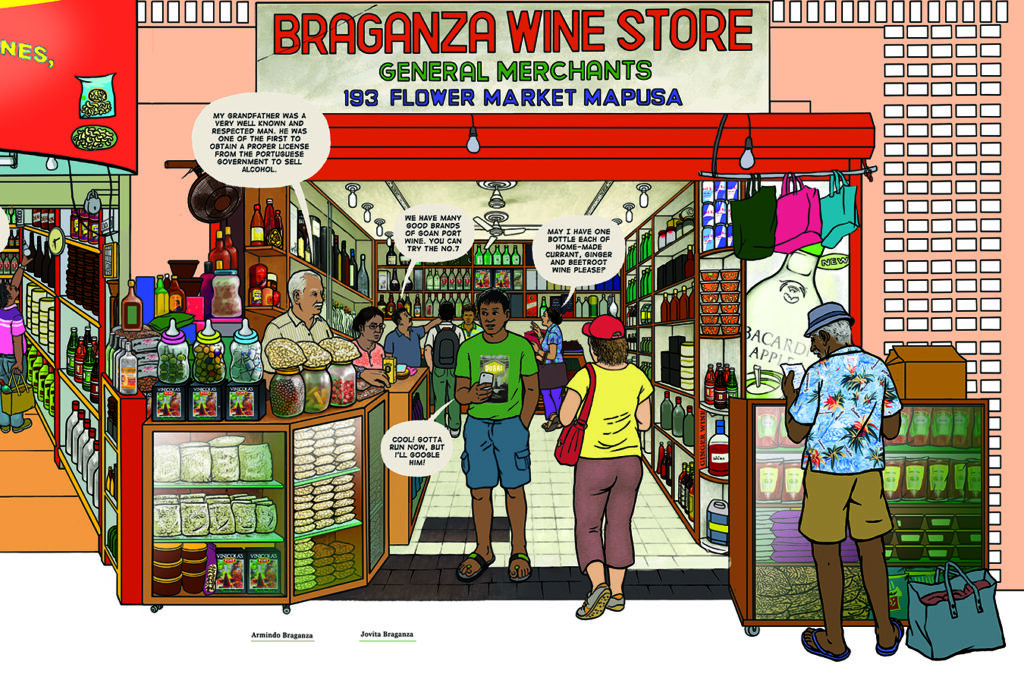
BRAGANZA WINES. One of the oldest liquor merchants in Goa, Braganza Wine Stores is a family-run business currently owned by Armindo and Jovita Braganza. Like several other small businesses in Mapusa, they give space to local cottage industries and domestic producers of traditional Goan products alongside the bigger commercial brands. In this image, one can see Feni maker (wearing a hat and printed shirt) just outside the shop, checking his accounts after having delivered a consignment of Caju Feni to the Braganzas.
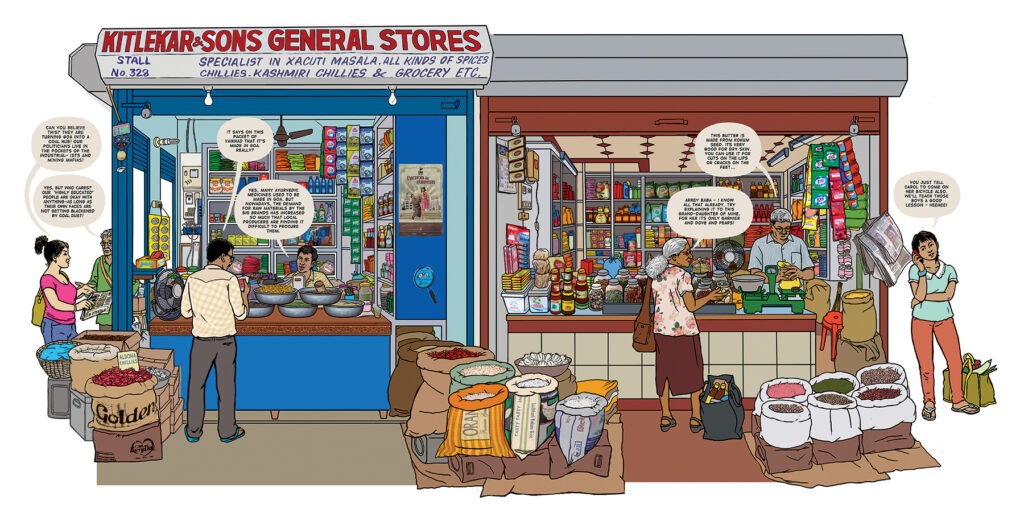
KITLEKAR ROW. Kitlekar and Sons is also a family-run General Store that deals in a large variety of items of everyday domestic use. They stock everything from kitchen spices to pickles, teas to herbal remedies, detergents to toothbrushes, and even rice, lentils and dried foods. General Stores like this also act as places where customers from different villages bump into each other, and provide opportunities for them to talk about price rise, government policies and a host of other subjects.
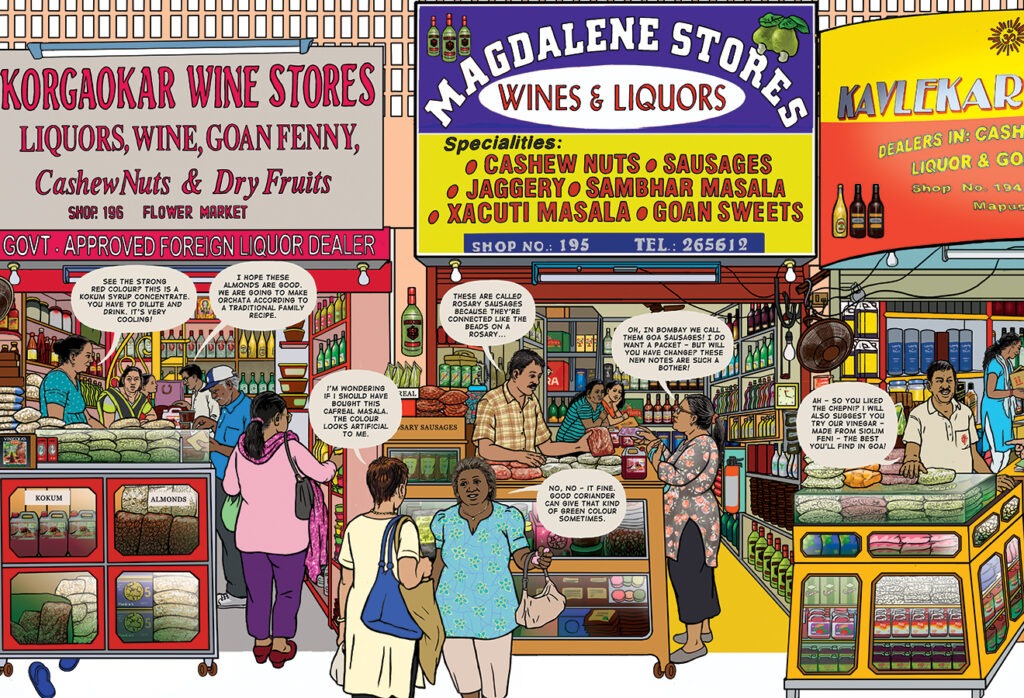
MAGDALENE STORES. Magdalene Stores is one in a row of shops that are primarily Liquor shops but also stock certain specialised items such as Choriso (sometimes known as rosary sausages because they are strung together like rows of rosary beads) and pre-packaged spice mixes for specific Goan recipes such as Cafreal, Xacuti and Vindaloo.
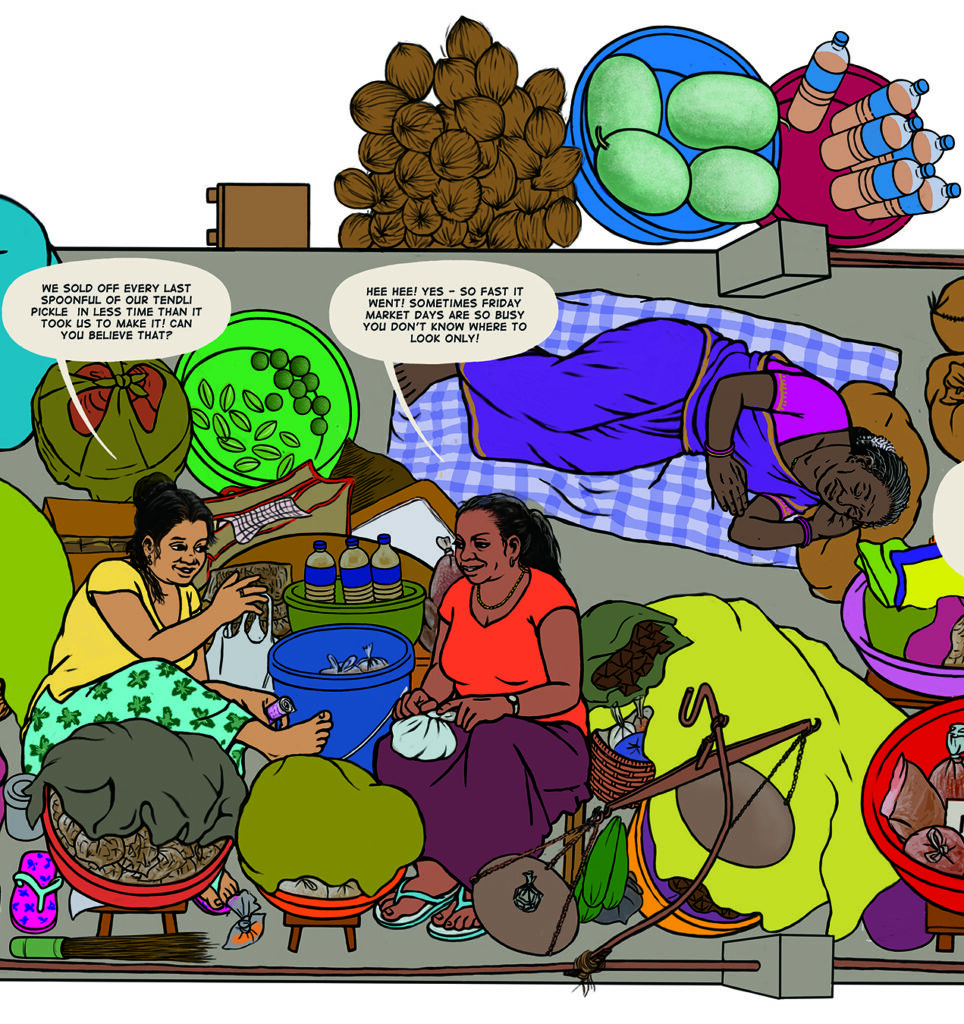
MARKET DAY. Friday is the special market day in Mapusa. On this day, women and men from nearby as well far-flung villages around Mapusa arrive early in the morning with produce from their homes, gardens and farms to sell at the famous ‘Friday Bazaar’. They usually spend the entire day in the market and return only when their stocks run out. It can be exhausting for some, and it is not unusual to see some of the vendors taking time off for a siesta in the afternoon, surrounded by their goods, squeezed into whatever little space they find. Mapusa, already a crowded market on other days, can be impossibly jam-packed on Fridays!
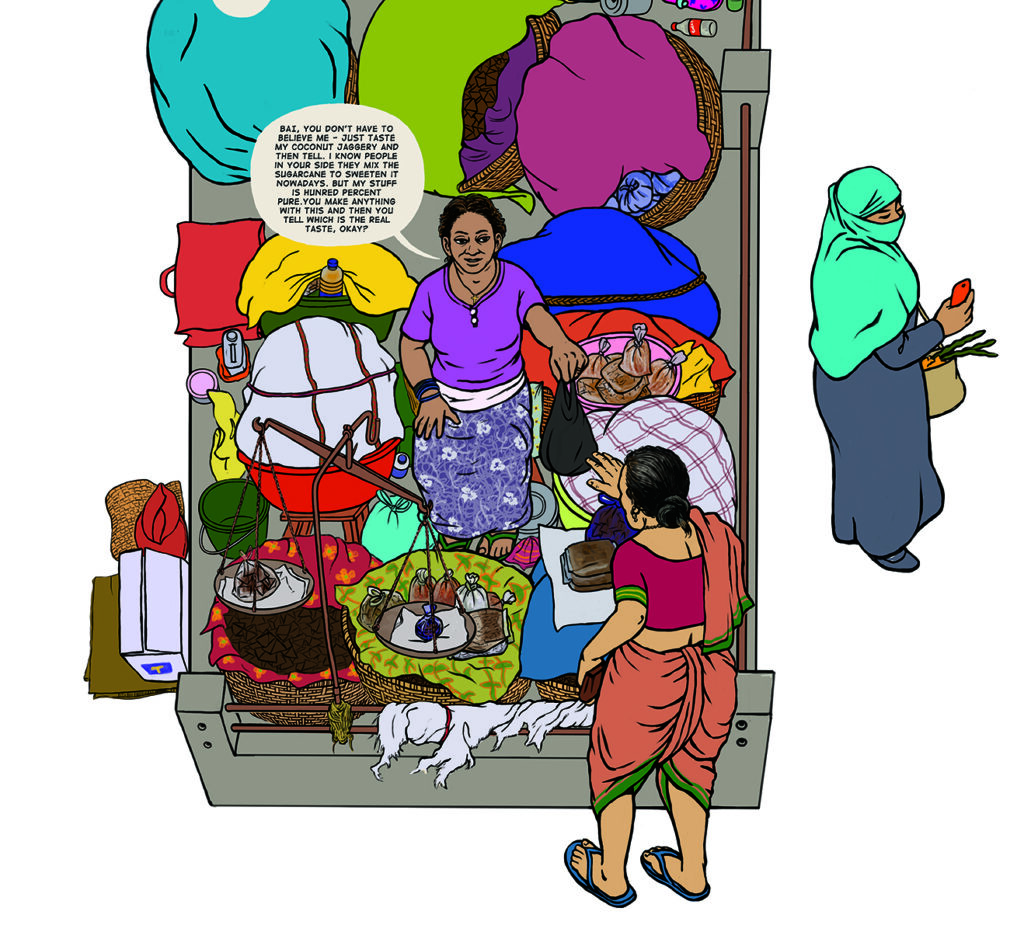
MILAGRES PLATFORM. One of the interesting features of Mapusa market are the platforms that are rented by vendors who don’t own proper lock-able shops. Vendors have rights to use the platforms they rent for extended periods of time, and sometimes even pass on the right to their family members. Milagres Fernandes has been operating from her platform for many years, and sells mostly home-made coconut jaggery.
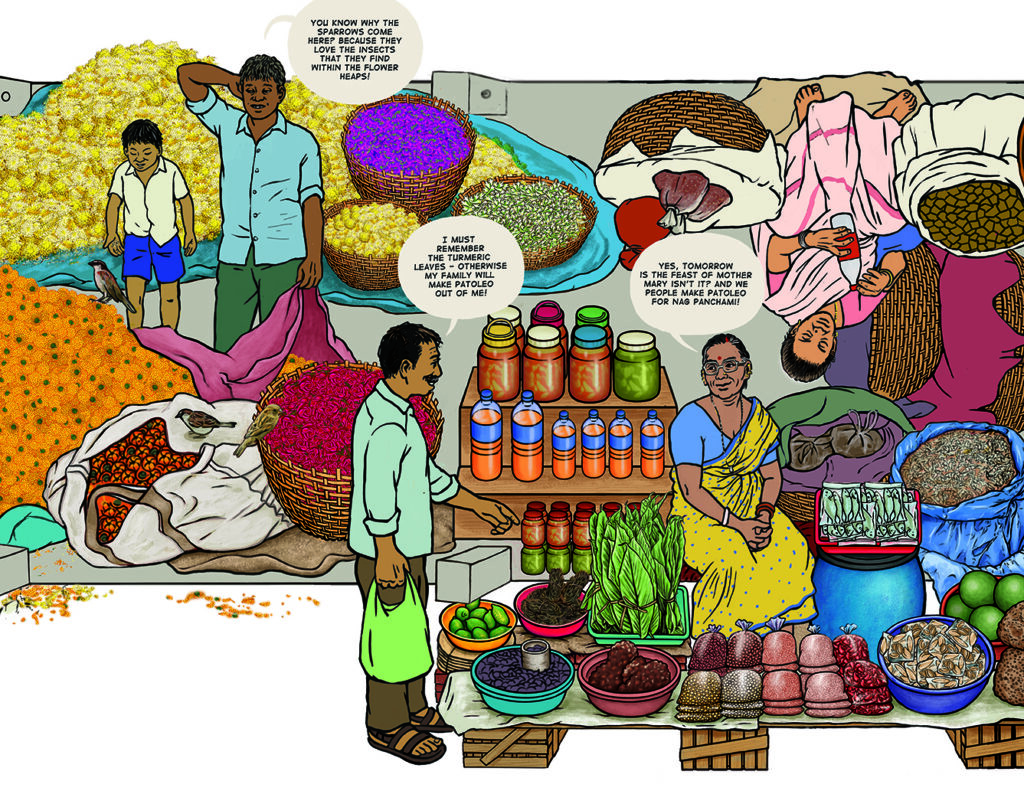
PATOLEO. Some of the items available in Mapusa market change with the seasons and festivals, giving it a different feel at such times. The appearance of fresh turmeric leaves and large volumes of flowers in the market signify the arrival of Nag Panchami on the eve of the big Ganesh Chaturthi festival. Patoleo are stuffed turmeric-leaf wraps, a dish which is common to Goa, Maharashtra and parts of Karnataka on the western coast of India. They are made from freshly shredded coconut, rice flour paste and coconut jaggery, and are cooked by wrapping and steaming in turmeric leaves. Goan Christians, on the other hand, prepare Patoleo for the feast of Assumption of the Blessed Virgin Mary on the 15th August.
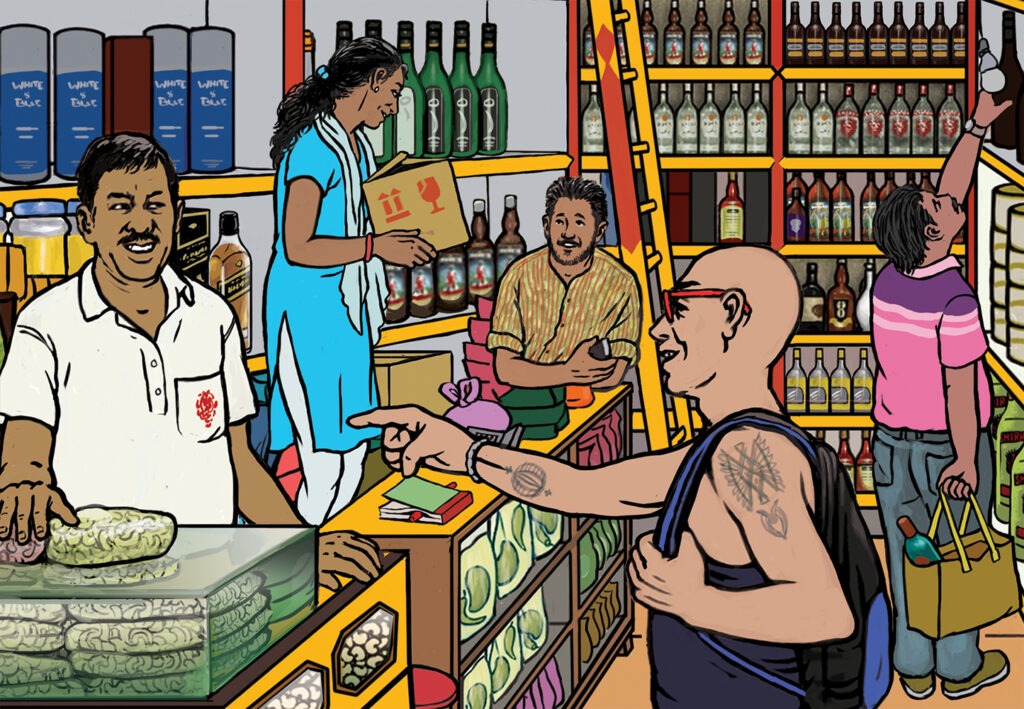
THE GIRL IN THE WINE SHOP. This image depicts the story of an imaginary romance blooming between a girl who is a shop assistant in a wine store and a young man who visits regularly to deliver pickled mangoes, roasted cashew nuts, and other savories that are also sold in the store as accompaniments for alcohol buyers.
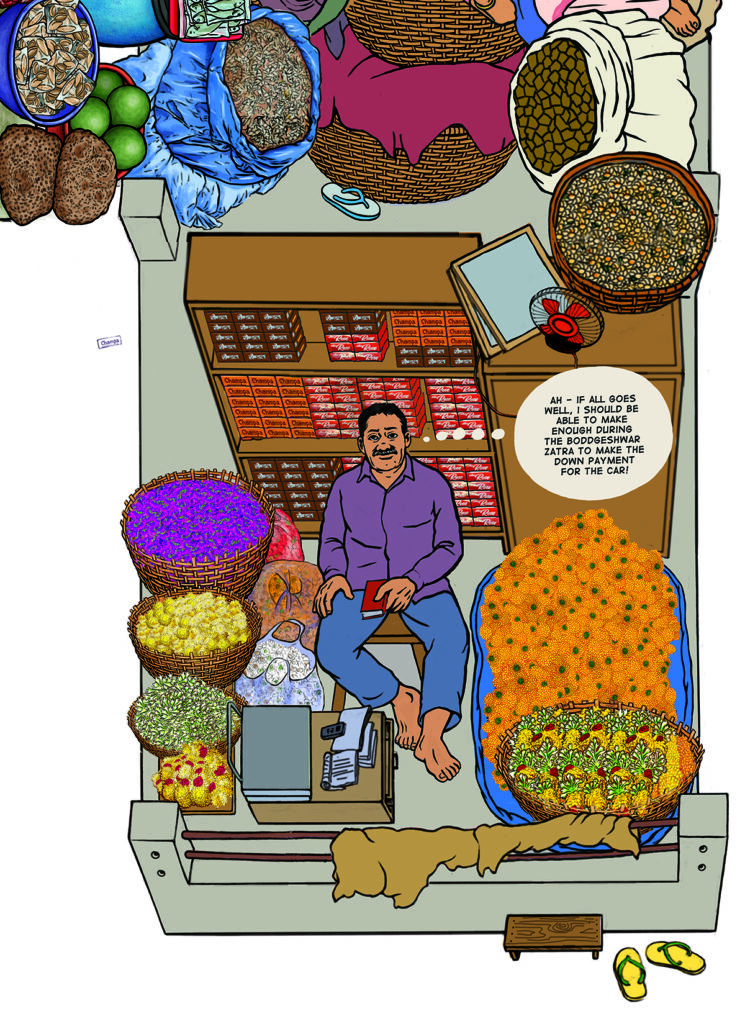
THE WHIFF OF MONEY. Mapusa market attracts traders and entrepreneurs, not only from different regions of Goa but also from surrounding States — particularly Karnataka and Maharashtra. Many of them come to this thriving market with hopes of making it big. Not everyone finds success of course, but those who do help create spaces for others to join.

VICTORY’S MARKET CAFE. There are a number of small watering holes within the market for thirsty shoppers on hot days, serving beer and small eats. This humorous scene shows tourists and travelers from different times and places in history meeting at Victory’s Market Cafe and competing with each other to declare their long associations with, and love for, Goa.

TAILOR’S ROW. Mapusa has a small section of the market that is demarcated for job-work tailors who are always ready to take up quick tailoring, repairing, and adjusting jobs for customers. This is a remarkable convenience not usually available in other markets. These tailors likely began to thrive during the 1960s and 70s when Western Hippies, attracted by Goa’s pristine beaches, warm climate, and easygoing lifestyles, began to flock here in large numbers, spending months at a time. They needed cheaper, lighter, colorful ‘Indian-style’ clothes, which they would often get custom-made from the Mapusa tailors.
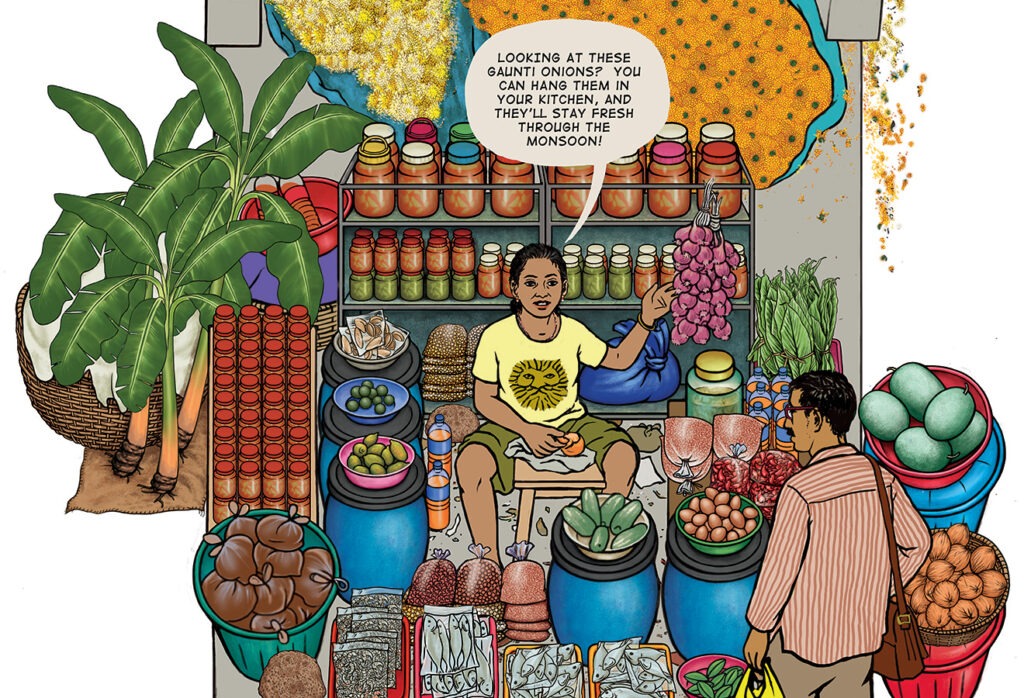
PICKLES AND SQUASHES. Seller of home-made pickles, preserves and garden produce in Mapusa market. It is because the market creates a vital link between local producers and local consumers that many Goan traditional food and farming practises continue to thrive and survive despite the onslaught of commercial food brands, factory-farmed products and supermarkets pushing global and imported foods.
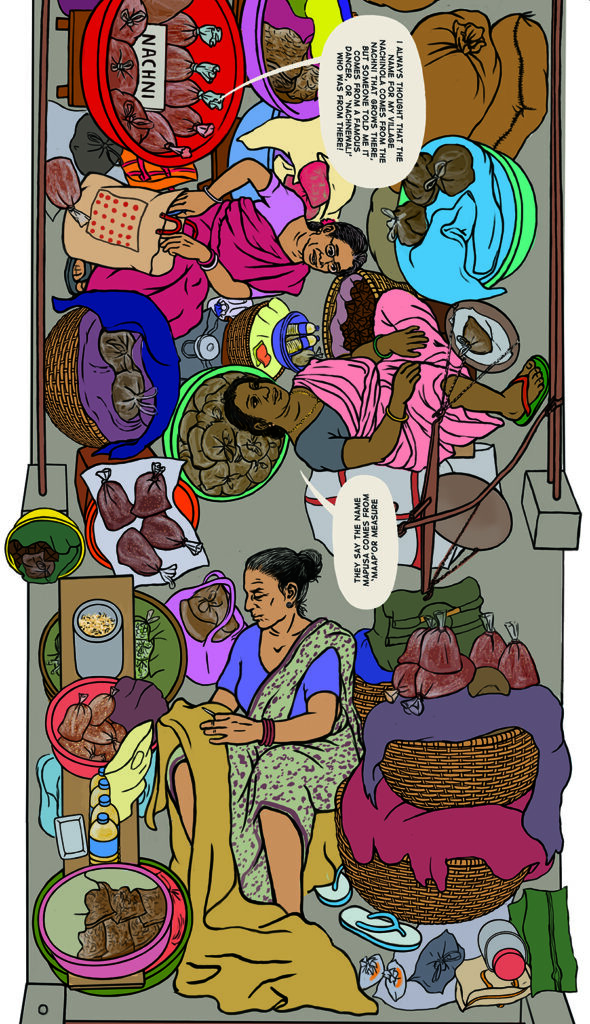
NACHNI SELLERS. Nachni, or Foxtail Millet, grows in the hilly parts of Goa, and has been a part of the Goan diet for centuries. Though it was one of the most widely consumed millets, its production had slowly been declining due to a growing preference for rice and other factors. However, Nachni production has seen a revival in recent times after contemporary scientific research has demonstrated its myriad benefits — from its overall dietary positives (including its role in combatting modern diseases like diabetes) to improving soil health and drought tolerance.


